Yatong An
Digitally Prototype Your Eye Tracker: Simulating Hardware Performance using 3D Synthetic Data
Mar 20, 2025



Abstract:Eye tracking (ET) is a key enabler for Augmented and Virtual Reality (AR/VR). Prototyping new ET hardware requires assessing the impact of hardware choices on eye tracking performance. This task is compounded by the high cost of obtaining data from sufficiently many variations of real hardware, especially for machine learning, which requires large training datasets. We propose a method for end-to-end evaluation of how hardware changes impact machine learning-based ET performance using only synthetic data. We utilize a dataset of real 3D eyes, reconstructed from light dome data using neural radiance fields (NeRF), to synthesize captured eyes from novel viewpoints and camera parameters. Using this framework, we demonstrate that we can predict the relative performance across various hardware configurations, accounting for variations in sensor noise, illumination brightness, and optical blur. We also compare our simulator with the publicly available eye tracking dataset from the Project Aria glasses, demonstrating a strong correlation with real-world performance. Finally, we present a first-of-its-kind analysis in which we vary ET camera positions, evaluating ET performance ranging from on-axis direct views of the eye to peripheral views on the frame. Such an analysis would have previously required manufacturing physical devices to capture evaluation data. In short, our method enables faster prototyping of ET hardware.
Quasi-calibration method for structured light system with auxiliary camera
Mar 02, 2024Abstract:The structured light projection technique is a representative active method for 3-D reconstruction, but many researchers face challenges with the intricate projector calibration process. To address this complexity, we employs an additional camera, temporarily referred to as the auxiliary camera, to eliminate the need for projector calibration. The auxiliary camera aids in constructing rational model equations, enabling the generation of world coordinates based on absolute phase information. Once calibration is complete, the auxiliary camera can be removed, mitigating occlusion issues and allowing the system to maintain its compact single-camera, single-projector design. Our approach not only resolves the common problem of calibrating projectors in digital fringe projection systems but also enhances the feasibility of diverse-shaped 3D imaging systems that utilize fringe projection, all without the need for the complex projector calibration process.
PointACL:Adversarial Contrastive Learning for Robust Point Clouds Representation under Adversarial Attack
Sep 14, 2022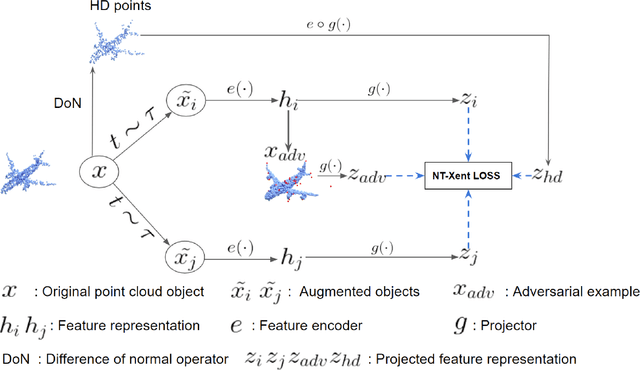



Abstract:Despite recent success of self-supervised based contrastive learning model for 3D point clouds representation, the adversarial robustness of such pre-trained models raised concerns. Adversarial contrastive learning (ACL) is considered an effective way to improve the robustness of pre-trained models. In contrastive learning, the projector is considered an effective component for removing unnecessary feature information during contrastive pretraining and most ACL works also use contrastive loss with projected feature representations to generate adversarial examples in pretraining, while "unprojected " feature representations are used in generating adversarial inputs during inference.Because of the distribution gap between projected and "unprojected" features, their models are constrained of obtaining robust feature representations for downstream tasks. We introduce a new method to generate high-quality 3D adversarial examples for adversarial training by utilizing virtual adversarial loss with "unprojected" feature representations in contrastive learning framework. We present our robust aware loss function to train self-supervised contrastive learning framework adversarially. Furthermore, we find selecting high difference points with the Difference of Normal (DoN) operator as additional input for adversarial self-supervised contrastive learning can significantly improve the adversarial robustness of the pre-trained model. We validate our method, PointACL on downstream tasks, including 3D classification and 3D segmentation with multiple datasets. It obtains comparable robust accuracy over state-of-the-art contrastive adversarial learning methods.
3DG-STFM: 3D Geometric Guided Student-Teacher Feature Matching
Jul 06, 2022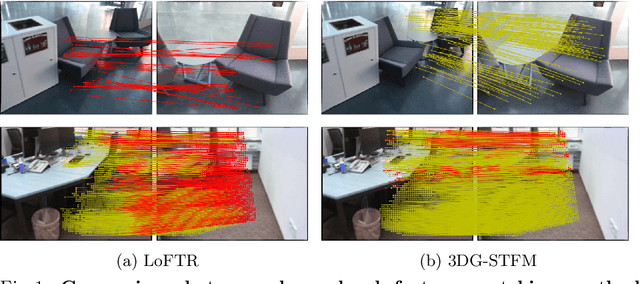
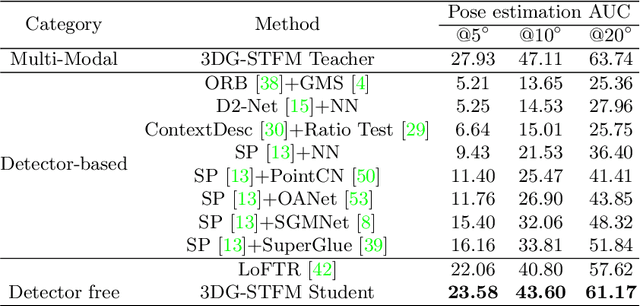
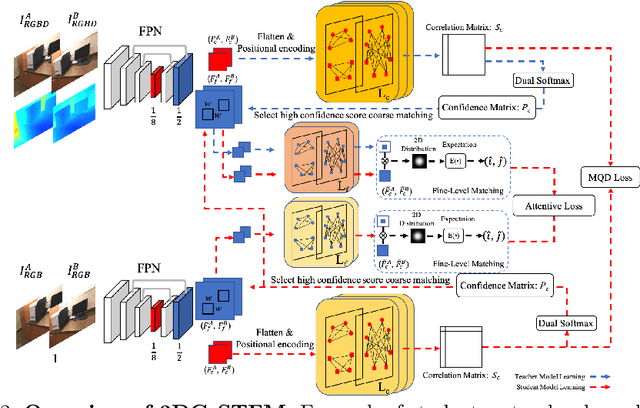
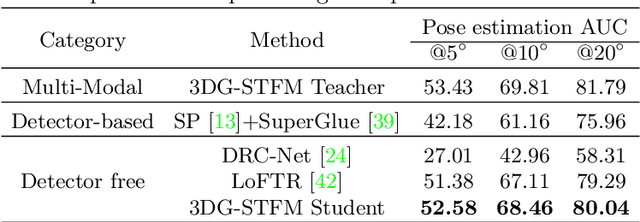
Abstract:We tackle the essential task of finding dense visual correspondences between a pair of images. This is a challenging problem due to various factors such as poor texture, repetitive patterns, illumination variation, and motion blur in practical scenarios. In contrast to methods that use dense correspondence ground-truths as direct supervision for local feature matching training, we train 3DG-STFM: a multi-modal matching model (Teacher) to enforce the depth consistency under 3D dense correspondence supervision and transfer the knowledge to 2D unimodal matching model (Student). Both teacher and student models consist of two transformer-based matching modules that obtain dense correspondences in a coarse-to-fine manner. The teacher model guides the student model to learn RGB-induced depth information for the matching purpose on both coarse and fine branches. We also evaluate 3DG-STFM on a model compression task. To the best of our knowledge, 3DG-STFM is the first student-teacher learning method for the local feature matching task. The experiments show that our method outperforms state-of-the-art methods on indoor and outdoor camera pose estimations, and homography estimation problems. Code is available at: https://github.com/Ryan-prime/3DG-STFM.
 Add to Chrome
Add to Chrome Add to Firefox
Add to Firefox Add to Edge
Add to Edge